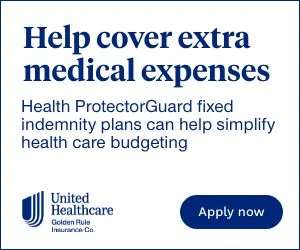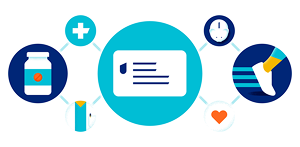If you’ve been to the pharmacy recently to pick up a prescription, you know that the costs may vary. Some of your prescriptions may be reasonably priced, while others may give you sticker shock.
You probably won’t be surprised to learn that the average drug price increased by about 15% from January 2022 to January 2023. That’s according to the U.S. Department of Health and Human Services. That translates to almost $600 for some medications.
Although your health insurance often covers some of that cost, you could still be left with big prescription drug bills.
One way to help soften the blow to your wallet is to consider a prescription discount card, advises Nicole Broadhurst, B.C.P.A. She’s lead medical billing advocate at Tennessee Health Advocates in Nashville, Tennessee.
Prescription discount cards provide lower drug costs to you if you pay for your medication in cash. There’s no cost to use them, and you don’t even need to have health insurance to get them, notes Broadhurst.
Below, learn what prescription discount cards are, what you can do with them, and how they might save you money.
Did you know that some short-term medical insurance plans offer prescription discount cards? Explore them online today.
How do prescription discount cards work?
Here’s some great news: Most prescription discount cards are available to you at no cost. And you can get them on the internet or with a mobile app, says Broadhurst. Then you present it at participating pharmacies, just like how you’d give them your health insurance card.
Just remember that prescription discount cards can’t be combined with your prescription drug coverage. “It’s something people need to think about, because any medication costs aren’t applied toward your insurance deductible or out-of-pocket maximum,” Broadhurst explains. (Your deductible is the amount you pay for covered healthcare services before your insurance plan pays. Your out-of-pocket maximum is the most you’ll have to pay for covered health care services in a plan year.)
When might you not want to use prescription discount cards?
Do you take a lot of medications, and are their prices helping you meet your deductible or out-of-pocket maximum? In that case, Broadhurst suggests that you skip using your prescription discount card.
When is a good time to use your prescription discount cards?
If you’re on just a few medications, maybe one for high blood pressure, it may make sense to use your card, notes Broadhurst. That’s because it could save you some money. Just do a quick comparison of what it will cost if you go through insurance versus using your prescription discount card. Sometimes, it may be cheaper to go through your insurance, while in other cases it makes sense to pay cash with your card, she advises.
Your health insurance program may offer you access to a free discount drug card. With UnitedHealthcare, for example, you may have access to Optum Perks, which may allow you to get discounts on most prescription drugs at over 64,000 locations nationwide.
The card covers thousands of prescription drugs approved by the U.S. Food and Drug Administration (FDA). These include prescriptions for:
- Depression and anxiety
- High blood pressure
- High cholesterol
You can download the Optum Perks app for free and search your prescriptions for any available discounts to see how much you can save. (No insurance is required, so you can still get a card even if you don’t have a UnitedHealthcare plan.)
Get limited prescription drug coverage with some short-term medical insurance plans. Explore your options today.]
How do I get discounted prescription drugs?
Prescription discount cards aren’t the only way you can save on medications. Here are some of Broadhurst’s other tips:
Tip #1: Get generic drugs when you can. “Hands down, this is usually one of the easiest ways to save money on prescription medications,” says Broadhurst. While generic drugs have the same active ingredients and may have the same effects as brand-name drugs, they can cost anywhere from 80% to 85% less, according to the Federal Trade Commission.
Tip #2: See if you’re eligible for a mail-order pharmacy. If you have health insurance, you may be able to save more by moving to a mail-order pharmacy, Broadhurst notes. These may offer better savings and can be found online or through national chains. “Sometimes this is a good way to get a 3-month supply of prescriptions, rather than just one month at a time,” says Broadhurst.
Tip #3: Join a discount program. Some drug companies offer patient assistance programs based on your income and health needs. You can apply directly to the company for a discount card for free or discounted medications.
There are also other programs that may help. These include:
- Medicine Assistance Tool. This connects underinsured people with patient assistance programs.
- NeedyMeds. This provides information on resources that help people who can’t afford their medications and health care costs, and it also offers eligible patients a free drug discount card.
You can also check with your local pharmacy. Some have started to use their own prescription discount programs, says Broadhurst. You can also tell your pharmacist that you find your copayment for your prescription too expensive. (A copayment is a fixed amount you pay for a covered health service.) They might be able to locate a coupon for you from the drug’s manufacturer.
You don’t have to wait for open enrollment to get short-term medical insurance and limited prescription coverage. In many cases, you can get covered as early as the next day. Find out how online, or contact a licensed insurance agent at 1-844-211-7730 for more information.
For informational purposes only. This information is compiled by UnitedHealthcare, and/or one of its affiliates, and does not diagnose problems or recommend specific treatment. Services and medical technologies referenced herein may not be covered under your plan. Please consult directly with your primary care physician if you need medical advice.
Sources:
Centers for Medicare & Medicaid Services. “Pharmaceutical manufacturer patient assistance program information.” September 6, 2023. Retrieved from https://www.cms.gov/medicare/coverage/prescription-drug-coverage/patient-assistance-program
Federal Trade Commission. “How to get generic drugs and low-cost prescriptions.” October 2023. Retrieved from https://consumer.ftc.gov/articles/generic-drugs-low-cost-prescriptions
Medicine Assistance Tool. “Meet MAT, the Medicine Assistance Tool.” Retrieved from https://medicineassistancetool.org/ Accessed April 23, 2024
NeedyMeds. “Simplified healthcare savings.” Retrieved from https://www.needymeds.org/ Accessed April 23, 2024
Optum Perks. “Get your free prescription discount card.” Retrieved from https://perks.optum.com/discount-card Accessed June 6, 2024.
U.S. Department of Health and Human Services: Assistant Secretary for Planning and Evaluation. “Changes in the list prices of prescription drugs, 2017–2023.” October 6, 2023. Retrieved from https://aspe.hhs.gov/reports/changes-list-prices-prescription-drugs
Compliance code:
51108-X-0425








